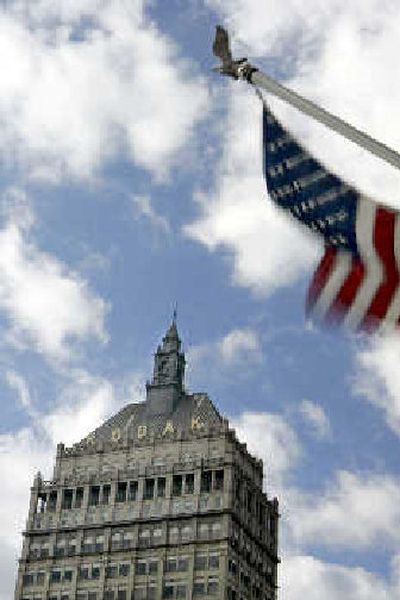A muddy picture at Kodak

ROCHESTER, N.Y. — Halfway through a four-year digital makeover, as its quarterly losses mount, Eastman Kodak Co. has some analysts wondering if the picture-taking pioneer is headed for a breakup.
But even as Kodak reported a $1.03 billion loss for the third quarter, its new leadership — largely recruited from digital heavyweights like Hewlett-Packard Co. — says the results show they’re making real progress symbolized by one historic milestone: Sales of digital products now exceed revenue from film-based photography for the first time.
Patent-rich Kodak, they also point out, is No. 1 in sales of digital cameras and digital X-ray systems in the United States and photo kiosks, thermal home printers and online photo services worldwide.
“Overall, we’re expecting a year of good progress in a historic transition,” said Chief Executive Antonio Perez, a former Hewlett-Packard stalwart who took the helm in June.
Others, however, predict that the multiyear transformation, which includes the elimination of 25,000 jobs, almost inevitably will lead to even bigger changes in the years ahead.
“They’ll probably make it to digital but it may not be the Kodak we know,” said Christopher Hayes, chief investment officer of Hayes-Fischer Capital Management of Rochester.
“As you go from a monopoly to a commodity type of business, you could see Kodak split up in different pieces,” he said. “I think people feel that way more, now that you have non-Kodak people running the company. There’s not as much allegiance.”
At an investor’s meeting last month, CEO Perez scaled back short-term profit expectations — in part because of fears that high gasoline prices and Gulf Coast hurricane damage will slow the economy. But he was bullish about prospects for 2006 and beyond.
“We are at the phase now where digital is still coming up,” Perez said. “You’ll start to see it next year very clearly. Three years ago, film was still here, so it was covering up a lot of the sins. And last year … it was still covering up some of the sins. So we are at the worst possible place.”
Kodak shares briefly hit a two-year low Wednesday when the company reported its fourth quarterly loss in a row, which included $900 million in non-cash charges related to its huge overhaul. In trading Friday, Kodak closed at $22.29 — at the low end of a 52-week range of $20.91 to $35.19.
The biggest news in the earnings release may have been that digital sales surged 47 percent to $1.89 billion.
Kodak is hoping film, its cash cow for a century, will continue to bring enough cash as it steadies on its new bearing. But the clock is running down. Third-quarter revenues from traditional businesses fell 20 percent to $1.66 billion, and film sales could drop more than 30 percent in the United States this year.
Kodak and Japanese archrival Fuji Photo Film Co. aren’t the only film-and-paper manufacturers reeling from ever fiercer competition as the digital revolution sweeps through. Germany’s AgfaPhoto, which has failed to find a buyer, warned Wednesday of the possibility of going out of business by year-end.
Kodak finally acknowledged in fall 2003 that its analog businesses were in irreversible decline and outlined a strategy to become a digital front runner in photography, health imaging and commercial printing by 2007.
It embarked on a nearly $3 billion shopping spree but also began shutting film, paper and other raw-materials factories around the world. By 2007, its work force could plummet to World War II levels of under 50,000, down from 75,100 in 2001 and a peak of 145,300 in 1988.
By 2008, Kodak expects 80 percent of revenues will come from digital and overall sales will top $17 billion, up from $13.52 billion last year. The health-imaging wing, which accounts for 20 percent of sales, and the swelling graphic communications business will increase profits steadily through 2009, it said.
•Weyerhaeuser Co. reported a steep drop in third-quarter profits Friday, and the forest products company said it expects the residual effects of recent hurricanes and other industry pressures to hurt fourth-quarter earnings.
For the third quarter ended Sept. 25, Weyerhaeuser said earnings fell 52 percent to $285 million, or $1.16 per share, from $594 million, or $2.45 per share, in the comparable period last year. Total net sales and revenue edged down to $5.6 billion from $5.68 billion in the year-ago period.
•AT&T Corp. painted a positive picture Friday with what may be its final earnings report before becoming part of SBC Communications Inc., topping Wall Street forecasts with third-quarter income of $520 million and boosting its revenue forecast for the second time this year.
The profit reported Friday amounted to 64 cents per share for the three months ended Sept. 30.
•Xerox Corp. on Friday said third-quarter profit slid sharply on litigation and other one-time charges, but the results excluding those items met Wall Street expectations.
The Stamford, Conn.-based maker of copiers and printers said net income after preferred dividends declined to $49 million, or 5 cents per share, for the three months ended Sept. 30 from $149 million, or 17 cents per share, in the same quarter last year.